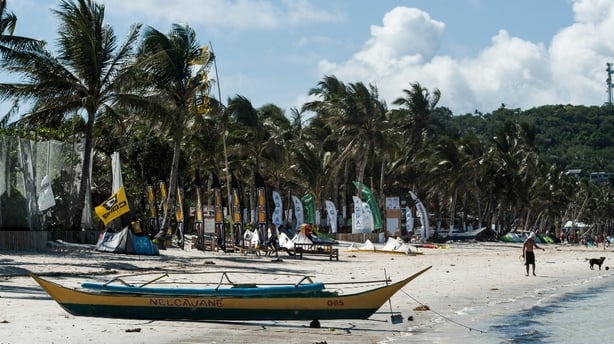A decision by Philippine President Rodrigo Duterte to shut the holiday hotspot of Boracay, which he has called a "cesspool", prompted airlines to cut flights today, as hotels prepared for cancellations and businesses appeared resigned to a move the government said was non-negotiable.
Mr Duterte ordered the closure of Boracay for six months from 26 April in a bid to rescue from ruin a once idyllic island that drew two million tourists and generated over $1bn in revenue last year.
Domestic airlines offered customers full refunds or flights elsewhere, but said they would still operate a limited number of flights to Boracay's gateways, Caticlan and Kalibo, to serve residents, which number about 50,000.
Discovery World Corp, which operates a lavish 88-room resort in Boracay, said the closure would have a significant impact on its financial health, citing the resort's large contribution to revenue. The company's shares dropped as much as 7.5% today.
The government made it clear it was ready to take a temporary hit on tourism.
"We have to swallow the bitter pill if we wish to sustain and protect the island of Boracay," Frederick Alegre, assistant secretary for tourism, told a news conference.
"It is a temporary setback but we will recover the glory days of Boracay."
Located off the northern tip of the central island of Panay, Boracay's white sand, lively nightlife and abundant water sports are a constant draw for visitors.

In recent years, growing numbers of Asian visitors, particularly from China, have been straining the resources of beach resorts in countries like Philippines and Thailand.
Since February, Philippine officials have been scrambling to inspect the island and record a catalogue of construction and permit breaches.
Mr Duterte, in one of his trademark public outbursts, attacked the explosion of unlicensed developments on the crowded 10-square-kilometre island, including encroachments on forest and beach land.
So far, the authorities have found 948 illegal structures, half of which they aim to destroy during the closure.
Priorities, officials said, were overhauls to roads, sewage treatment and waste disposal facilities to handle about 90 to 115 tons of waste a day, of which only 30 tons is brought out off the island, according to the interior ministry.
The local tourism industry has urged a delay to the planned closure and a gradual introduction, something the authorities say cannot work.
The government said it will have a two billion peso ($38.4m) "calamity fund" to try to help an estimated 30,000 people on Boracay whose livelihoods depend on tourism, directly and indirectly.
The impact on hotels and resorts has yet to be fully assessed.
Boracay, one of 7,300 islands in the archipelago nation, hosts 1,800 businesses, including global hotel chains like Shangri-La and Movenpick, and locally listed companies Megaworld Corp and Manila Water.
Some large operators welcomed the closure, saying it wouldcreate a more sustainable tourism environment, and make iteasier to complete ongoing construction work.
"It's good for us because it means a better Boracay aftersix months," said Monica Salomon, president of Global Estate, a subsidiary of Megaworld Corp, which is behind the140-hectare Boracay Newcoast project.

